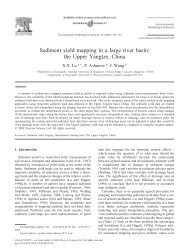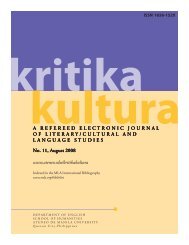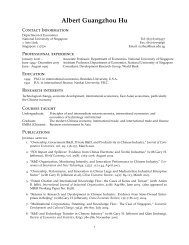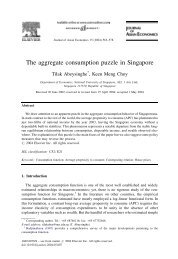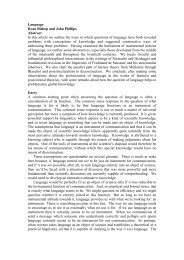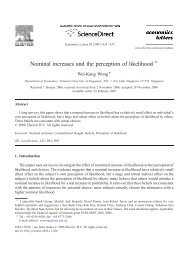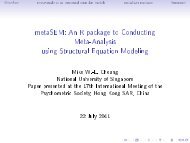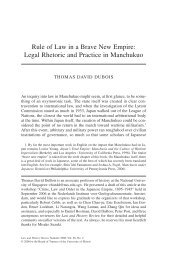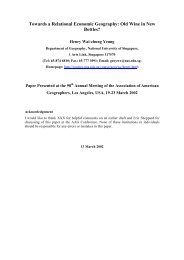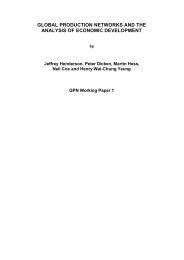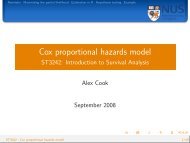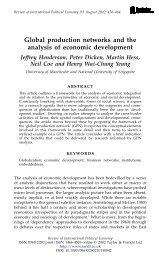Researching Hybridity in Social and Economic ... - NUS Home
Researching Hybridity in Social and Economic ... - NUS Home
Researching Hybridity in Social and Economic ... - NUS Home
Create successful ePaper yourself
Turn your PDF publications into a flip-book with our unique Google optimized e-Paper software.
Group. This Latourian actor network analysis shows how semi-private texts for the<br />
consumption of other f<strong>in</strong>ancial analysts <strong>and</strong> <strong>in</strong>vestors generated favourable views among<br />
actors <strong>in</strong> the <strong>in</strong>ternational f<strong>in</strong>ancial community <strong>and</strong> thereby enabled the smooth reorganization<br />
that, accord<strong>in</strong>g to London’s Sunday Times (12 January 1997), left the family patriarch “more<br />
firmly <strong>in</strong> control of his four listed companies, shifted value to his personal hold<strong>in</strong>gs <strong>and</strong><br />
<strong>in</strong>creased his group’s market value by £2 billion <strong>in</strong> two days”.<br />
Other f<strong>in</strong>ancial documents were used <strong>in</strong> Yeung (2004a) to showcase the significant<br />
transformations <strong>in</strong> the social organization of Ch<strong>in</strong>ese capitalism towards hybrid capitalism. In<br />
this case, Li Ka-sh<strong>in</strong>g made very good use of enroll<strong>in</strong>g f<strong>in</strong>ancial analysts <strong>in</strong>to his actor<br />
networks so that the legitimacy of his corporate reorganization can be established via these<br />
semi-private texts at the global level <strong>in</strong> major <strong>in</strong>ternational f<strong>in</strong>ancial centres. This enrollment<br />
of non-Ch<strong>in</strong>ese elites (f<strong>in</strong>ancial analysts) <strong>in</strong>to “Ch<strong>in</strong>ese” bus<strong>in</strong>ess networks represents a<br />
pragmatic strategy for lead<strong>in</strong>g Ch<strong>in</strong>ese actors to capitalize on globalization tendencies<br />
(f<strong>in</strong>ancial globalization <strong>in</strong> this case). Biographies <strong>and</strong>/or oral histories of selected actors <strong>in</strong><br />
Ch<strong>in</strong>ese capitalism may also offer significant depth of <strong>in</strong>formation unavailable to most<br />
researchers (e.g. Chan <strong>and</strong> Chiang, 1994; Tsui-Auch, 2004). By def<strong>in</strong>ition, these secondary<br />
data were collected for different reasons <strong>and</strong> might conta<strong>in</strong> <strong>in</strong>herent bias. I was conv<strong>in</strong>ced that<br />
both primary <strong>and</strong> secondary data were needed to satisfy my criteria of data triangulation. 6 By<br />
triangulation, I mean the deployment of different research methods <strong>and</strong> thus different data to<br />
cross-verify <strong>and</strong> complement each other <strong>in</strong> an actual research process. In my project, I used<br />
personal <strong>in</strong>terviews (or close dialogue) to verify some of the data <strong>and</strong> <strong>in</strong>formation conta<strong>in</strong>ed<br />
<strong>in</strong> media <strong>and</strong> other unpublished reports. I also used secondary data to fill the gaps <strong>in</strong> primary<br />
data collected from <strong>in</strong>terviews with lead<strong>in</strong>g actors <strong>in</strong> Ch<strong>in</strong>ese capitalism.<br />
Hav<strong>in</strong>g identified the ma<strong>in</strong> actors <strong>in</strong> Ch<strong>in</strong>ese capitalism, it is now possible to trace the<br />
<strong>in</strong>terconnections of actors <strong>in</strong> “Ch<strong>in</strong>ese” bus<strong>in</strong>ess networks (see Figure 1). My earlier<br />
20



